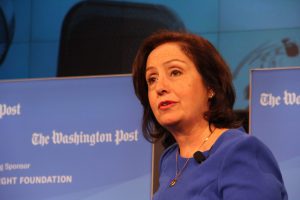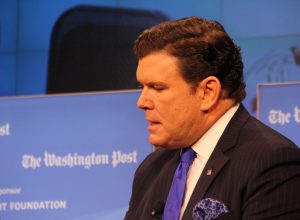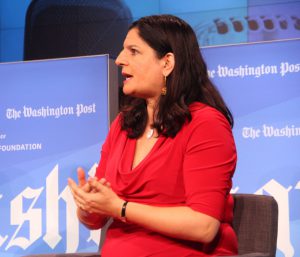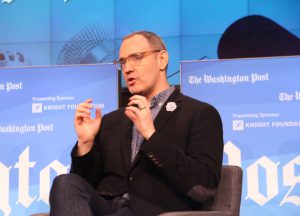%
of Americans believe the news media plays a critical or very important role in our democracy
%
of Americans say they can think of a news source that reports the news objectively
- of Democrats have a favorable opinion of the news media 54%
- of Republicans have an unfavorable opinion of news media 68%
WASHINGTON – Top journalists said Tuesday that President Donald Trump’s attacks on the press combined with the rise of deliberately false stories lead people to have less trust in the news media.
A national poll shows half of Americans think there are enough sources to get unbiased information. However, the survey, conducted by Gallup, Inc. and the Knight Foundation, also found that only 27 percent of Americans say they are “very confident” that they can tell when a news source is reporting factual news versus opinion or commentary.
BuzzFeed News Media Editor Craig Silverman, who helped popularize the term “fake news” as part of a 2014 research project, said that he defined “fake news” as stories that are 100 percent factually inaccurate,, intentionally deceptive and are created to make money for the perpetrators. Now, though, “fake news” can mean news you don’t like or phony information distributed for political reasons.
PBS NewsHour anchor Judy Woodruff, who joined Silverman and others in a discussion hosted by The Washington Post, said the repeated use of the “fake news” label by Trump maked Americans suspicious of journalists and the information they provide, which hurts democracy.
“I believe so passionately that a free press and news media is part of what holds our democracy together, and if enough Americans start thinking the press is not to be believed, then I think we’ve got a real problem,” she said.
The discussion occurred in the wake of Trump’s so-called “Fake News Awards”, which were presented on the Republican National Committee website last Wednesday, and included a roundup of articles with journalistic errors. While the majority of the reporting errors were corrected, the “highly anticipated” awards served as a catalyst for the president to criticize media outlets that he feels cover him unfairly.
Fox News Chief Political Anchor Bret Baier said social media has played a large part in affecting how the press has been perceived under the Trump administration.
“Let’s not sugarcoat it, the president has obviously used Twitter as a tool to attack the press, and that’s had an effect on all of us,” he said. “The challenge for reporters now is to be able to paint a picture that says ‘you decide what’s right and what’s wrong’ and not get mired by the tweet of the hour.”
Woodruff agreed with this sentiment, referring to Trump as a “news-making machine”. In comparison with past administrations, she said, covering the Trump administration has been a constant “blizzard” of news information being streamed through various social media platforms.
“For the past year we’ve changed the lineup of the show several times a day, including on a number of occasions right up until we’re on the air,” she said.
The journalists also touched on the role that both journalists and audience members have in promoting news literacy. The survey said that half of U.S. adults feel confident there are enough sources to allow people to cut through bias to sort out the facts in the news – down from 66 percent a generation ago.
Indira Lakshmanan, the Newmark chair in journalism ethics at The Poynter Ethics, explained that news organizations need to do a better job of deciphering different types of articles on their platforms in promoting better news literacy, using The Washington Post’s website as an example for other news organizations to look to.
“The Washington Post is a great example, of clicking – you hover with your mouse over any story and you can immediately see that’s analysis, that is opinion, that is news. You see what it is. We need to make it easy to say this is why you should trust us: we’re transparent, here are our tools and be honest about whatever it is you’re doing,” she added.
According to New York University journalism professor Jay Rosen, the relationship between news production and distribution has become disjointed. Social media has divided news organizations from their audiences, making it hard for those who produce news to meaningfully engage and reach their audiences.
“I think producers of news have to start forming strong relationships with the people that value their product, because they believe in the value of what you do and they understand how it differs from other forms of chatter,” he said. “You always have to have a strong, clear vision of where you’re going next.”












